IN BRIEF by Nancy R. Hofmann [email protected]
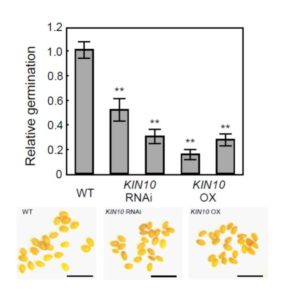 The economy of living cells includes energy production, energy utilization, and energy storage. Thus, a plant’s energy budget must connect the decision to produce lipids (for energy storage) with its overall energy status. Energy sensor kinases, such as KIN10 and KIN11 in Arabidopsis thaliana, are key transcriptional regulators that integrate energy and stress signaling networks (reviewed in Sheen, 2014). New work from Zhai et al. (2017) shows that they also connect energy status with the biosynthesis of lipid storage molecules.
The economy of living cells includes energy production, energy utilization, and energy storage. Thus, a plant’s energy budget must connect the decision to produce lipids (for energy storage) with its overall energy status. Energy sensor kinases, such as KIN10 and KIN11 in Arabidopsis thaliana, are key transcriptional regulators that integrate energy and stress signaling networks (reviewed in Sheen, 2014). New work from Zhai et al. (2017) shows that they also connect energy status with the biosynthesis of lipid storage molecules.
Given previous reports of seemingly conflicting effects of KIN10 overexpression on seeds— enhancing seed development and oil contents, but depressing seed germination rates— Zhai et al. revisited the question of what roles KIN10 plays in seeds. The authors compared seeds of KIN10 overexpression lines to those of wild type and KIN10-suppressed (RNAi) lines. Both transgenic lines, whether up- or down-regulated for KIN10, had smaller seeds than wild type, and both had poor germination compared to WT (see Figure 1), with significantly decreased levels of the fatty acid triacylglycerol (TAG).
This effect on TAG levels prompted Zhai et al. to probe the effects of KIN10 on WRINKLED1 (WRI1), a conserved regulator of TAG accumulation (Grimberg, 2015). Co-expression of Arabidopsis WRI1 and OLEOSIN1 (OLE1) in N. benthamiana leaves induces TAG accumulation by increasing fatty acid biosynthesis and storage lipid packaging. Zhai et al. found that this lipid accumulation was suppressed when WRI1 and OLE1 were co-expressed with KIN10 (or its close homolog KIN11). In the presence of KIN10, less WRI1 accumulated in N. benthamiana leaves, a decrease that was dependent on the proteasomal pathway and on an active kinase domain in KIN10. Zhai et al. found direct interaction of KIN10 (or KIN11) with WRI1 in the nucleus. Further, in vitro kinase assays showed that KIN10, in the presence of its activator GRIK1, could phosphorylate WRI1.
The authors went on to show that KIN10 likely phosphorylates WRI1 at two sites, each in a variant of the canonical KIN10 phosphorylation motif. Intriguingly, each of the WRI1 phosphorylation sites overlapped with an AP2 DNA binding domain, and when WRI1 target DNA was present in the kinase assay, phosphorylation of WRI1 was decreased. Phosphorylated WRI1 was degraded by Arabidopsis cell extracts more quickly than the non-phosphorylated form.
The results from Zhai et al. support a model in which WRI1, as a master regulator of TAG biosynthesis, is targeted for degradation by the proteasome pathway upon phosphorylation by the energy sensor KIN10. As KIN10 activity is negatively regulated by glucose, TAG biosynthesis would be favored when glucose is abundant. Thus, this work reveals an important mechanistic connection in energy homeostasis.
REFERENCES
Grimberg, A., Carlsson, A.S., Marttila, S., Bhalerao, R., and Hofvander, P. (2015). Transcriptional transitions in Nicotiana benthamiana leaves upon induction of oil synthesis by WRINKLED1 homologs from diverse species and tissues. BMC Plant Biol 15, 192.
Sheen, J. (2014). Master Regulators in Plant Glucose Signaling Networks. Journal of Plant Biology 57, 67-79.
Zhai, Z., Liu, H., and Shanklin, J. (2017). Phosphorylation of WRINKLED1 by KIN10 Results in its Proteasomal Degradation, Providing a Link Between Energy Homeostasis and Lipid Biosynthesis. Plant Cell. doi: 10.1105/tpc.17.00019.
 MONOPTEROS is an auxin-response factor (ARF) that is necessary for root formation during early embryogenesis. Its activity is modulated by BODENLOS (BDL), an Aux/IAA protein that is degraded in the presence of auxin. Möller et al. investigated the transcriptional targets of MP in very early embryos through the cell-specific expression of a stabilized BDL protein (bdl), which leads to a decrease in expression level of MP targets. The authors showed that MP targets include auxin-regulated genes and several transcription factors. Furthermore, they identified several MP targets that are crucial for ground tissue establishment, and showed that MP acts cell-autonomously in the specification of ground tissue and vascular tissue and that tissue initiation and tissue patterning can be regulated separately. Proc. Natl. Acad. Sci. 10.1073/pnas.1616493114
MONOPTEROS is an auxin-response factor (ARF) that is necessary for root formation during early embryogenesis. Its activity is modulated by BODENLOS (BDL), an Aux/IAA protein that is degraded in the presence of auxin. Möller et al. investigated the transcriptional targets of MP in very early embryos through the cell-specific expression of a stabilized BDL protein (bdl), which leads to a decrease in expression level of MP targets. The authors showed that MP targets include auxin-regulated genes and several transcription factors. Furthermore, they identified several MP targets that are crucial for ground tissue establishment, and showed that MP acts cell-autonomously in the specification of ground tissue and vascular tissue and that tissue initiation and tissue patterning can be regulated separately. Proc. Natl. Acad. Sci. 10.1073/pnas.1616493114

 The transcriptional response to auxin depends in large part on the interactions between ARF transcription factors and the Aux/IAA transcription inhibitors that interact with them. The crucial role of auxin in embryo patterning is revealed by the embryo patterning defects observed in mutants of ARF and Aux/IAA proteins as well as auxin synthesis and transport mutants. Mironova et al. review recent research into the role of auxin in embryo development, focusing on mathematical and structural models of auxin signaling, and particularly how a better understanding of the interactions amongst and between ARFs and Aux/IAA proteins enhances modeling efforts. Trends Plant Sci.
The transcriptional response to auxin depends in large part on the interactions between ARF transcription factors and the Aux/IAA transcription inhibitors that interact with them. The crucial role of auxin in embryo patterning is revealed by the embryo patterning defects observed in mutants of ARF and Aux/IAA proteins as well as auxin synthesis and transport mutants. Mironova et al. review recent research into the role of auxin in embryo development, focusing on mathematical and structural models of auxin signaling, and particularly how a better understanding of the interactions amongst and between ARFs and Aux/IAA proteins enhances modeling efforts. Trends Plant Sci.  In leaf mesophyll cells, some of the sugars produced by photosynthesis are stored as transitory starch, which is then broken down to provide the cells with energy during the night. Recent advances in imaging and staining and the use of mutants have enabled the pattern of accumulation of transitory starch in guard cells to be determined. Santelia and Lunn review these new insights and the special role of starch catabolism products (including malate) in stomatal opening in the light. The authors conclude, “Our aim in this review has been to highlight the exciting recent advances in our understanding of guard cell metabolism, with the hope of persuading young researchers to fall in love with stomata, and take up the challenge to explore their fascinating biology.” Plant Physiol.
In leaf mesophyll cells, some of the sugars produced by photosynthesis are stored as transitory starch, which is then broken down to provide the cells with energy during the night. Recent advances in imaging and staining and the use of mutants have enabled the pattern of accumulation of transitory starch in guard cells to be determined. Santelia and Lunn review these new insights and the special role of starch catabolism products (including malate) in stomatal opening in the light. The authors conclude, “Our aim in this review has been to highlight the exciting recent advances in our understanding of guard cell metabolism, with the hope of persuading young researchers to fall in love with stomata, and take up the challenge to explore their fascinating biology.” Plant Physiol. 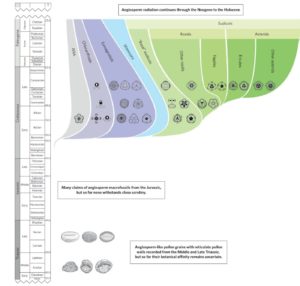 Although angiosperms are the dominant autotrophs in most parts of the world, their evolutionary origins remain somewhat mysterious. Herendeen et al. review the earliest evidence for angiosperms from the Early Cretaceous, and discuss fossil remains from earlier periods (Jurassic, Triassic) that have some angiosperm-like features. They conclude that none of these earlier fossils are unambiguously angiosperms, although they don’t rule out the possibility that one day a pre-Cretaceous angiosperm fossil will be found. Nature Plants
Although angiosperms are the dominant autotrophs in most parts of the world, their evolutionary origins remain somewhat mysterious. Herendeen et al. review the earliest evidence for angiosperms from the Early Cretaceous, and discuss fossil remains from earlier periods (Jurassic, Triassic) that have some angiosperm-like features. They conclude that none of these earlier fossils are unambiguously angiosperms, although they don’t rule out the possibility that one day a pre-Cretaceous angiosperm fossil will be found. Nature Plants 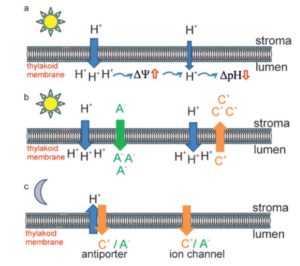 In photosynthesis, light energy generates proton motive force (pmf) across the thylakoid membrane. The establishment and maintenance of pmf involves numerous membrane transporters as well as other ions. Szabò and Septea review how various ions (including K+, Na+, Fe2+, Cu+, Mn2+, Ca2+, Cl–) contribute to photosynthetic efficiency, the approximate range of concentrations of each of these ions in various chloroplast compartments, and the transporters that enable them to cross membranes. The impact of the ion transportome on non-photochemical quenching (NPQ) is also discussed. J. Exp. Bot.
In photosynthesis, light energy generates proton motive force (pmf) across the thylakoid membrane. The establishment and maintenance of pmf involves numerous membrane transporters as well as other ions. Szabò and Septea review how various ions (including K+, Na+, Fe2+, Cu+, Mn2+, Ca2+, Cl–) contribute to photosynthetic efficiency, the approximate range of concentrations of each of these ions in various chloroplast compartments, and the transporters that enable them to cross membranes. The impact of the ion transportome on non-photochemical quenching (NPQ) is also discussed. J. Exp. Bot. 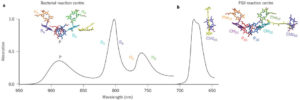 Nature journal published a special “Plant Insights” section featuring several excellent reviews. Zipfel and Oldroyd review Plant signalling in symbiosis and immunity (
Nature journal published a special “Plant Insights” section featuring several excellent reviews. Zipfel and Oldroyd review Plant signalling in symbiosis and immunity ( The economy of living cells includes energy production, energy utilization, and energy storage. Thus, a plant’s energy budget must connect the decision to produce lipids (for energy storage) with its overall energy status. Energy sensor kinases, such as KIN10 and KIN11 in Arabidopsis thaliana, are key transcriptional regulators that integrate energy and stress signaling networks (reviewed in
The economy of living cells includes energy production, energy utilization, and energy storage. Thus, a plant’s energy budget must connect the decision to produce lipids (for energy storage) with its overall energy status. Energy sensor kinases, such as KIN10 and KIN11 in Arabidopsis thaliana, are key transcriptional regulators that integrate energy and stress signaling networks (reviewed in  Over the past several decades, the amount of maize produced in the US Midwestern “Corn Belt” has been rising steadily. In order to accurately predict future grain yields, the factors that contribute to these recent yield increases must be identified. Tollenaar et al. found that more than a quarter (27%) of recent US maize yield increases are a consequence of “solar brightening” – an increase in the amount of light reaching the Earth’s surface in these growing regions. Solar brightening and dimming are affected by clouds but also by air quality. In other parts of the world, declining air quality has led to solar dimming. The authors argue that the beneficial impacts on grain yield should be considered when calculating the costs associated with efforts to protect air quality, and also that the effect of solar brightening is not likely to continue to increase, making the case that genetic sources of yield improvement will be even more important for future yield increases. Nature Climate Change
Over the past several decades, the amount of maize produced in the US Midwestern “Corn Belt” has been rising steadily. In order to accurately predict future grain yields, the factors that contribute to these recent yield increases must be identified. Tollenaar et al. found that more than a quarter (27%) of recent US maize yield increases are a consequence of “solar brightening” – an increase in the amount of light reaching the Earth’s surface in these growing regions. Solar brightening and dimming are affected by clouds but also by air quality. In other parts of the world, declining air quality has led to solar dimming. The authors argue that the beneficial impacts on grain yield should be considered when calculating the costs associated with efforts to protect air quality, and also that the effect of solar brightening is not likely to continue to increase, making the case that genetic sources of yield improvement will be even more important for future yield increases. Nature Climate Change 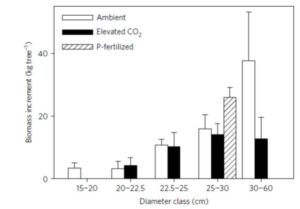 The “Law of the Minimum” put forth by Justus von Liebig states that the most limiting nutrient governs plant growth. Although there is evidence in some conditions that increasing atmospheric CO2 levels can enhance plant growth, this only holds true under conditions in which CO2 is limiting growth. Ellsworth et al. found no productivity gains in mature eucalypt forest growing on phosphate-poor soils when CO2 levels were raised. When phosphate fertilizer was added and so growth was no longer P- limited, they observed a growth enhancement with elevated CO2. These results demonstrate the need to consider the availability of soil nutrients when forecasting plant responses to elevated CO2. Nature Climate Change
The “Law of the Minimum” put forth by Justus von Liebig states that the most limiting nutrient governs plant growth. Although there is evidence in some conditions that increasing atmospheric CO2 levels can enhance plant growth, this only holds true under conditions in which CO2 is limiting growth. Ellsworth et al. found no productivity gains in mature eucalypt forest growing on phosphate-poor soils when CO2 levels were raised. When phosphate fertilizer was added and so growth was no longer P- limited, they observed a growth enhancement with elevated CO2. These results demonstrate the need to consider the availability of soil nutrients when forecasting plant responses to elevated CO2. Nature Climate Change